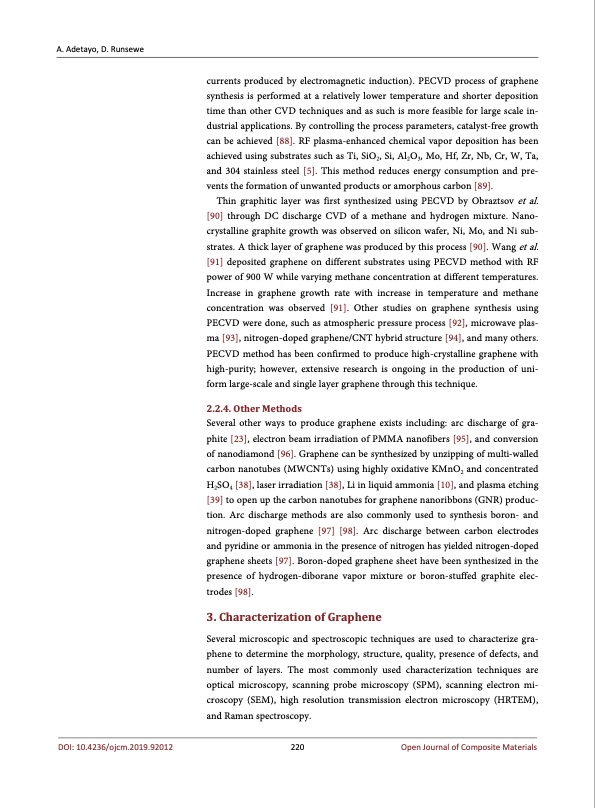PDF Publication Title:
Text from PDF Page: 014
A. Adetayo, D. Runsewe currents produced by electromagnetic induction). PECVD process of graphene synthesis is performed at a relatively lower temperature and shorter deposition time than other CVD techniques and as such is more feasible for large scale in- dustrial applications. By controlling the process parameters, catalyst-free growth can be achieved [88]. RF plasma-enhanced chemical vapor deposition has been achieved using substrates such as Ti, SiO2, Si, Al2O3, Mo, Hf, Zr, Nb, Cr, W, Ta, and 304 stainless steel [5]. This method reduces energy consumption and pre- vents the formation of unwanted products or amorphous carbon [89]. Thin graphitic layer was first synthesized using PECVD by Obraztsov et al. [90] through DC discharge CVD of a methane and hydrogen mixture. Nano- crystalline graphite growth was observed on silicon wafer, Ni, Mo, and Ni sub- strates. A thick layer of graphene was produced by this process [90]. Wang et al. [91] deposited graphene on different substrates using PECVD method with RF power of 900 W while varying methane concentration at different temperatures. Increase in graphene growth rate with increase in temperature and methane concentration was observed [91]. Other studies on graphene synthesis using PECVD were done, such as atmospheric pressure process [92], microwave plas- ma [93], nitrogen-doped graphene/CNT hybrid structure [94], and many others. PECVD method has been confirmed to produce high-crystalline graphene with high-purity; however, extensive research is ongoing in the production of uni- form large-scale and single layer graphene through this technique. 2.2.4. Other Methods Several other ways to produce graphene exists including: arc discharge of gra- phite [23], electron beam irradiation of PMMA nanofibers [95], and conversion of nanodiamond [96]. Graphene can be synthesized by unzipping of multi-walled carbon nanotubes (MWCNTs) using highly oxidative KMnO2 and concentrated H2SO4 [38], laser irradiation [38], Li in liquid ammonia [10], and plasma etching [39] to open up the carbon nanotubes for graphene nanoribbons (GNR) produc- tion. Arc discharge methods are also commonly used to synthesis boron- and nitrogen-doped graphene [97] [98]. Arc discharge between carbon electrodes and pyridine or ammonia in the presence of nitrogen has yielded nitrogen-doped graphene sheets [97]. Boron-doped graphene sheet have been synthesized in the presence of hydrogen-diborane vapor mixture or boron-stuffed graphite elec- trodes [98]. 3. Characterization of Graphene Several microscopic and spectroscopic techniques are used to characterize gra- phene to determine the morphology, structure, quality, presence of defects, and number of layers. The most commonly used characterization techniques are optical microscopy, scanning probe microscopy (SPM), scanning electron mi- croscopy (SEM), high resolution transmission electron microscopy (HRTEM), and Raman spectroscopy. DOI: 10.4236/ojcm.2019.92012 220 Open Journal of Composite MaterialsPDF Image | Synthesis and Fabrication of Graphene and Graphene Oxide

PDF Search Title:
Synthesis and Fabrication of Graphene and Graphene OxideOriginal File Name Searched:
OJCM-2019042814574897.pdfDIY PDF Search: Google It | Yahoo | Bing
Salgenx Redox Flow Battery Technology: Power up your energy storage game with Salgenx Salt Water Battery. With its advanced technology, the flow battery provides reliable, scalable, and sustainable energy storage for utility-scale projects. Upgrade to a Salgenx flow battery today and take control of your energy future.
CONTACT TEL: 608-238-6001 Email: greg@infinityturbine.com (Standard Web Page)